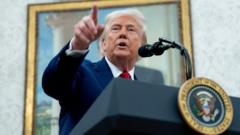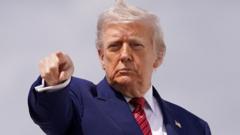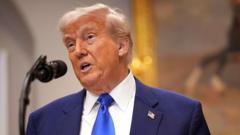**Trade negotiations between the U.S. and E.U. are highlighted by the imminent July deadline for new tariffs, emphasizing contrasting priorities and the complexities of reaching an agreement.**
**U.S. and E.U. Intensify Trade Negotiations Amid Tariff Concerns**

**U.S. and E.U. Intensify Trade Negotiations Amid Tariff Concerns**
**Discussions progress as both sides aim for a compromise before pending tariffs take effect.**
In an ongoing effort to address trade tensions, the United States and European Union have initiated serious negotiations, marked by a conversation between U.S. Commerce Secretary Howard Lutnick and E.U. Trade Commissioner Maros Sefcovic. This dialogue follows President Trump's decision to postpone a 50 percent tariff on all E.U. imports, providing both parties additional time to work towards a resolution.
Recently, Trump engaged in talks with Ursula von der Leyen, the president of the European Commission, which were characterized by an E.U. spokesperson as revitalizing the negotiation process. The aim is to forge a mutual understanding well ahead of July 9, when the new levies are scheduled to begin.
Despite this optimistic backdrop, challenges remain, as differing priorities between the two sides persist without any clear changes in the demands or proposals currently under consideration. The E.U. continues to advocate for a significant reduction in tariffs on industrial goods, suggesting that eliminating them entirely could be a viable outcome. Concurrently, the E.U. is working to finalize a list of counter-tariffs aimed at U.S. goods, potentially affecting products such as machinery, soybeans, and even bourbon.
On the U.S. side, the administration is urging reform in the E.U.’s consumption tax system and its regulatory landscape concerning digital goods. However, European officials have been resistant to these requests, complicating the negotiation effort further. The outcome of these discussions would not only impact economic relations but could also set the tone for future collaborations or confrontations across the Atlantic.
Recently, Trump engaged in talks with Ursula von der Leyen, the president of the European Commission, which were characterized by an E.U. spokesperson as revitalizing the negotiation process. The aim is to forge a mutual understanding well ahead of July 9, when the new levies are scheduled to begin.
Despite this optimistic backdrop, challenges remain, as differing priorities between the two sides persist without any clear changes in the demands or proposals currently under consideration. The E.U. continues to advocate for a significant reduction in tariffs on industrial goods, suggesting that eliminating them entirely could be a viable outcome. Concurrently, the E.U. is working to finalize a list of counter-tariffs aimed at U.S. goods, potentially affecting products such as machinery, soybeans, and even bourbon.
On the U.S. side, the administration is urging reform in the E.U.’s consumption tax system and its regulatory landscape concerning digital goods. However, European officials have been resistant to these requests, complicating the negotiation effort further. The outcome of these discussions would not only impact economic relations but could also set the tone for future collaborations or confrontations across the Atlantic.




















